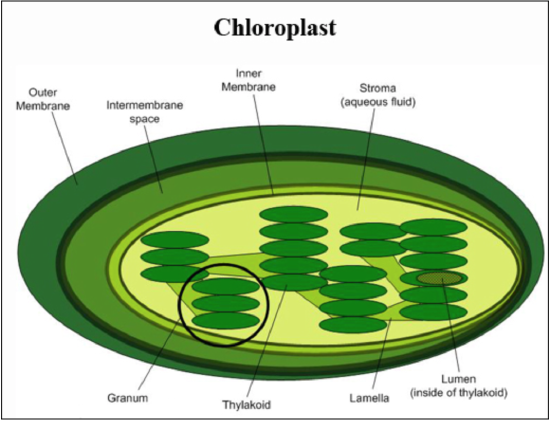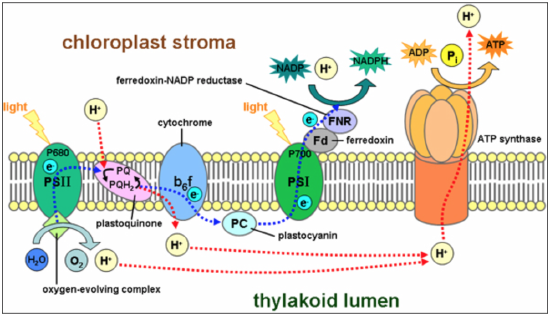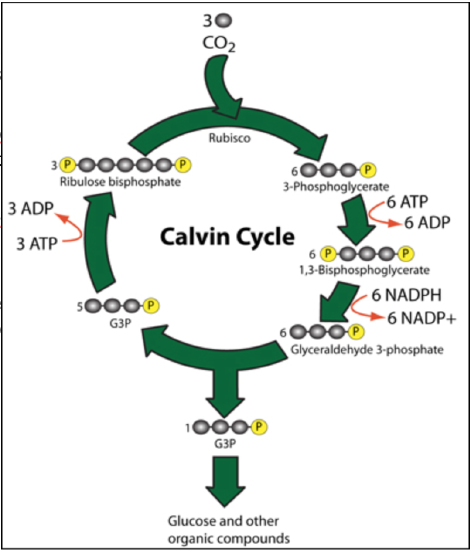Photosynthesis
- Page ID
- 23969
\( \newcommand{\vecs}[1]{\overset { \scriptstyle \rightharpoonup} {\mathbf{#1}} } \)
\( \newcommand{\vecd}[1]{\overset{-\!-\!\rightharpoonup}{\vphantom{a}\smash {#1}}} \)
\( \newcommand{\dsum}{\displaystyle\sum\limits} \)
\( \newcommand{\dint}{\displaystyle\int\limits} \)
\( \newcommand{\dlim}{\displaystyle\lim\limits} \)
\( \newcommand{\id}{\mathrm{id}}\) \( \newcommand{\Span}{\mathrm{span}}\)
( \newcommand{\kernel}{\mathrm{null}\,}\) \( \newcommand{\range}{\mathrm{range}\,}\)
\( \newcommand{\RealPart}{\mathrm{Re}}\) \( \newcommand{\ImaginaryPart}{\mathrm{Im}}\)
\( \newcommand{\Argument}{\mathrm{Arg}}\) \( \newcommand{\norm}[1]{\| #1 \|}\)
\( \newcommand{\inner}[2]{\langle #1, #2 \rangle}\)
\( \newcommand{\Span}{\mathrm{span}}\)
\( \newcommand{\id}{\mathrm{id}}\)
\( \newcommand{\Span}{\mathrm{span}}\)
\( \newcommand{\kernel}{\mathrm{null}\,}\)
\( \newcommand{\range}{\mathrm{range}\,}\)
\( \newcommand{\RealPart}{\mathrm{Re}}\)
\( \newcommand{\ImaginaryPart}{\mathrm{Im}}\)
\( \newcommand{\Argument}{\mathrm{Arg}}\)
\( \newcommand{\norm}[1]{\| #1 \|}\)
\( \newcommand{\inner}[2]{\langle #1, #2 \rangle}\)
\( \newcommand{\Span}{\mathrm{span}}\) \( \newcommand{\AA}{\unicode[.8,0]{x212B}}\)
\( \newcommand{\vectorA}[1]{\vec{#1}} % arrow\)
\( \newcommand{\vectorAt}[1]{\vec{\text{#1}}} % arrow\)
\( \newcommand{\vectorB}[1]{\overset { \scriptstyle \rightharpoonup} {\mathbf{#1}} } \)
\( \newcommand{\vectorC}[1]{\textbf{#1}} \)
\( \newcommand{\vectorD}[1]{\overrightarrow{#1}} \)
\( \newcommand{\vectorDt}[1]{\overrightarrow{\text{#1}}} \)
\( \newcommand{\vectE}[1]{\overset{-\!-\!\rightharpoonup}{\vphantom{a}\smash{\mathbf {#1}}}} \)
\( \newcommand{\vecs}[1]{\overset { \scriptstyle \rightharpoonup} {\mathbf{#1}} } \)
\( \newcommand{\vecd}[1]{\overset{-\!-\!\rightharpoonup}{\vphantom{a}\smash {#1}}} \)
\(\newcommand{\avec}{\mathbf a}\) \(\newcommand{\bvec}{\mathbf b}\) \(\newcommand{\cvec}{\mathbf c}\) \(\newcommand{\dvec}{\mathbf d}\) \(\newcommand{\dtil}{\widetilde{\mathbf d}}\) \(\newcommand{\evec}{\mathbf e}\) \(\newcommand{\fvec}{\mathbf f}\) \(\newcommand{\nvec}{\mathbf n}\) \(\newcommand{\pvec}{\mathbf p}\) \(\newcommand{\qvec}{\mathbf q}\) \(\newcommand{\svec}{\mathbf s}\) \(\newcommand{\tvec}{\mathbf t}\) \(\newcommand{\uvec}{\mathbf u}\) \(\newcommand{\vvec}{\mathbf v}\) \(\newcommand{\wvec}{\mathbf w}\) \(\newcommand{\xvec}{\mathbf x}\) \(\newcommand{\yvec}{\mathbf y}\) \(\newcommand{\zvec}{\mathbf z}\) \(\newcommand{\rvec}{\mathbf r}\) \(\newcommand{\mvec}{\mathbf m}\) \(\newcommand{\zerovec}{\mathbf 0}\) \(\newcommand{\onevec}{\mathbf 1}\) \(\newcommand{\real}{\mathbb R}\) \(\newcommand{\twovec}[2]{\left[\begin{array}{r}#1 \\ #2 \end{array}\right]}\) \(\newcommand{\ctwovec}[2]{\left[\begin{array}{c}#1 \\ #2 \end{array}\right]}\) \(\newcommand{\threevec}[3]{\left[\begin{array}{r}#1 \\ #2 \\ #3 \end{array}\right]}\) \(\newcommand{\cthreevec}[3]{\left[\begin{array}{c}#1 \\ #2 \\ #3 \end{array}\right]}\) \(\newcommand{\fourvec}[4]{\left[\begin{array}{r}#1 \\ #2 \\ #3 \\ #4 \end{array}\right]}\) \(\newcommand{\cfourvec}[4]{\left[\begin{array}{c}#1 \\ #2 \\ #3 \\ #4 \end{array}\right]}\) \(\newcommand{\fivevec}[5]{\left[\begin{array}{r}#1 \\ #2 \\ #3 \\ #4 \\ #5 \\ \end{array}\right]}\) \(\newcommand{\cfivevec}[5]{\left[\begin{array}{c}#1 \\ #2 \\ #3 \\ #4 \\ #5 \\ \end{array}\right]}\) \(\newcommand{\mattwo}[4]{\left[\begin{array}{rr}#1 \amp #2 \\ #3 \amp #4 \\ \end{array}\right]}\) \(\newcommand{\laspan}[1]{\text{Span}\{#1\}}\) \(\newcommand{\bcal}{\cal B}\) \(\newcommand{\ccal}{\cal C}\) \(\newcommand{\scal}{\cal S}\) \(\newcommand{\wcal}{\cal W}\) \(\newcommand{\ecal}{\cal E}\) \(\newcommand{\coords}[2]{\left\{#1\right\}_{#2}}\) \(\newcommand{\gray}[1]{\color{gray}{#1}}\) \(\newcommand{\lgray}[1]{\color{lightgray}{#1}}\) \(\newcommand{\rank}{\operatorname{rank}}\) \(\newcommand{\row}{\text{Row}}\) \(\newcommand{\col}{\text{Col}}\) \(\renewcommand{\row}{\text{Row}}\) \(\newcommand{\nul}{\text{Nul}}\) \(\newcommand{\var}{\text{Var}}\) \(\newcommand{\corr}{\text{corr}}\) \(\newcommand{\len}[1]{\left|#1\right|}\) \(\newcommand{\bbar}{\overline{\bvec}}\) \(\newcommand{\bhat}{\widehat{\bvec}}\) \(\newcommand{\bperp}{\bvec^\perp}\) \(\newcommand{\xhat}{\widehat{\xvec}}\) \(\newcommand{\vhat}{\widehat{\vvec}}\) \(\newcommand{\uhat}{\widehat{\uvec}}\) \(\newcommand{\what}{\widehat{\wvec}}\) \(\newcommand{\Sighat}{\widehat{\Sigma}}\) \(\newcommand{\lt}{<}\) \(\newcommand{\gt}{>}\) \(\newcommand{\amp}{&}\) \(\definecolor{fillinmathshade}{gray}{0.9}\)1. Description of Photosynthesis
Among all the living organisms, only plants are capable of producing their own food and obtaining energy from it. By producing energy, plants supply all the necessary nutrients and energy, directly or indirectly, to all other living organisms.
How do plants produce their own food?
The process of photosynthesis allows plants to capture the energy found in sunlight and use that energy to convert carbon dioxide and water into glucose. Glucose provides a form of chemical energy which plants use to grow and function. Oxygen is also released during this process. Photosynthesis makes life possible.
Chloroplasts
Photosynthesis is the process by which the energy in sunlight is converted into chemical energy. Photosynthesis in plants takes place in the chloroplasts. The green color of a leaf comes from chlorophyll, a pigment found inside chloroplasts. A double membrane surrounds the chloroplast. The dense fluid found within the chloroplast is called stroma. Thylakoids are an elaborate system of interconnected membrane sacs. It is here, in the thylakoid membrane, where chlorophyll is found and photosynthesis takes place.

Figure \(\PageIndex{1}\). Chloroplast (CC BY-NC-SA; It'sJustMe)
2 Stages of Photosynthesis
Photosynthesis can be summarized by the following equation:

Figure \(\PageIndex{2}\). Photosynthesis overview (CC BY-NC-SA; Daniel Mayer)
The process of photosynthesis is actually 2 processes:
-
Light Reactions: convert solar energy (sunlight) to chemical energy (ATP and NADPH).
-
Calvin Cycle (Light Independent Reactions): incorporates carbon dioxide from the air into organic molecules, which are converted to sugar.
Chlorophyll and the other molecules involved in the light reactions are built into the thylakoid membranes. The enzymes that catalyze the Calvin Cycle are located in the stroma of the chloroplast. Light reactions convert sunlight energy into chemical energy in the form of ATP and NADPH. This process starts when sunlight is absorbed by chlorophyll. The ATP and NADPH made by the light reactions are then used by the Calvin Cycle to convert cardbon dioxide to sugar. The ATP provides the energy and the NADPH supplies electrons needed during the Calvin Cycle. The ADP and NADP+ that are leftover from the Calvin Cycle are shuttled back to the light reactions to regenerate ATP and NADPH.

Figure \(\PageIndex{3}\). (CC BY-NC-SA)
Light Reactions
Sunlight is used to produce ATP and NADPH in the light reactions. The molecules involved in the light reactions are found in the thylakoid membrane.
Important players in the Light Reactions
Photosystem I (PSI) & Photosystem II (PSII): contain chlorophyll molecules as well as other proteins and are responsible for moving electrons from water to NADP+ to form NADPH.
Electron transport chain: generates a store of potential energy in the form of a hydrogen ion gradient in the thylakoid space, with the H+ concentration in the thylakoid being higher than that found in the stroma.
ATP synthase: uses the energy generated by the hydrogen ion gradient to produce ATP.

Figure \(\PageIndex{4}\). Photosynthesis (CC BY-NC-SA; Tameeria)
The light-dependent reactions take place in 5 stages:
1. Capturing light: Pigment molecules (chlorophyll) are anchored into place within the photosystem complexes by a lattice of proteins. The precise positioning of the pigment molecules allows them to capture photons (little packets of energy).
2. Exciting an electron: The position of the chlorophyll molecules within the photosystem is such that when a photon of light strikes any chlorophyll molecule in the photosytem, the excitation passes from one chlorophyll to another. Eventually, the energy arrives at a key chlorophyll molecule that is touching a membrane bound protein. The excited electron is then tranferred from that key chlorophyll molecule to an acceptor molecule in the membrane.
3. Electron Transport: The excited electron is then shuttled along a series of electron-carrier molecules embedded in the membrane. This is called the electron transport system. The energy from the electron is released in small amounts as the electron passes along the electron transport system. This energy is used to pump hydrogen ions (protons, H+) across the membrane, creating a high concentration of protons on one side of the membrane.
4. Making ATP: The high concentration of protons can be used as an energy source to make ATP molecules. Protons are restricted from crossing the membrane and are only able to move back across the membrane in special channels. The movement of protons as they pass through the ATP synthase drives the conversion of ADP to ATP. This process is called chemiosmosis and makes the ATP that will be used in the Calvin Cycle to make carbohydrates.
5. Making NADPH: Once the electron leaves the transport system, it enters another photosystem where it is re-energized by the absorption of another photon of light. The newly energized electron enters another electron transport system where it is again passed along a series of electron-carrier molecules. The electron is eventually transferred to a molecule of NADP+ and with the addition of a hydrogen ion, is used to create a molecule of NADPH. Both ATP and NADPH are important for the synthesis of carbohydrates in the Calvin Cycle.

Figure \(\PageIndex{5}\). Z-scheme (CC BY-NC-SA; Bensaccount)
Calvin Cycle
The Calvin Cycle uses the ATP and NADPH produced by the light reactions to convert three molecules of carbon dioxide to one molecule of a 3-carbon sugar. The plant can then utilize this small sugar to make larger sugars such as glucose and other organic compounds.
Phase 1: Carbon Fixation: Carbon dioxide comes into the stroma of the chloroplast. The enzyme rubisco catalyzes the bonding of carbon dioxide to Ribulose bisphophate to create an unstable 6-carbon molecule that immediately splits into two 3-carbon molecules of 3-phosphoglycerate.
Phase 2: Reduction: Each 3-phosphoglycerate molecule is phosphorylated by ATP to create 1,3-bisphosphoglycerate. NADPH donates a pair of electrons and reduces 1,3-bisphosphoglycerate, which loses a phosphate group and becomes glyceraldehyde 3-phophate (G3P).
Phase 3: Regeneration: For every six molecules of G3P created, five molecules continue on to phase 3, while one leaves to be used for the production of organic compounds. ATP is needed to phosphorylate G3P to regenerate Ribulose bisphosphate.

Figure \(\PageIndex{6}\). Z-scheme (CC BY-NC-SA; Bensaccount)

Photosynthesis Tutorial by Dr. Katherine Harris is licensed under a Creative Commons Attribution-NonCommercial-ShareAlike 3.0 Unported License.
Funded by the U.S. Department of Education, College Cost Reduction and Access (CCRAA) grant award # P031C080096.


